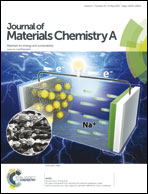Pt/single-stranded DNA/graphene nanocomposite with improved catalytic activity and CO tolerance†
Abstract
ssDNA was employed to readily disperse reduced graphene oxide (RGO) to form ssDNA–RGO composites, which could be used as a superior support to expediently electrodeposit Pt to synthesize ssDNA–RGO/cotton-flower-like-Pt nanocomposites (ssDNA–RGO/cf-Pt). The formation of cotton-flower-like-Pt clusters was due to the assistance of nitrogen atoms and phosphate groups in ssDNA. The catalytic activity of the ssDNA–RGO/cf-Pt nanocomposite for methanol oxidation was 2.5 fold of RGO/Pt and 3.8 fold of commercial Pt NPs. The outstanding catalytic activity of this novel catalyst was attributed to the very large surface of the highly conductive ssDNA–RGO and cotton-flower-like-Pt clusters with an open structure. The latter was beneficial for mass transfer. In addition, the excellent ability of the ssDNA–RGO/cf-Pt nanocomposite against CO poisoning was found and the anti-poisoning ratio (If/Ib) of ssDNA–RGO/cf-Pt was 1.75 fold larger than those of RGO/Pt and commercial Pt NPs. The elevated oxidation of CO in the adsorption state may be due to ssDNA providing abundant oxygen groups as well as the residual oxygen species in the RGO. A possible mechanism for the improved catalytic activity and CO tolerance was deduced according to UV-visible, Raman, scanning electron microscopy (SEM), energy dispersive spectrometry (EDS), X-ray photoelectron spectroscopy (XPS) and cyclic voltammetry (CV) results.


 Please wait while we load your content...
Please wait while we load your content...